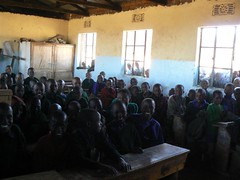The government is establishing new schools at a frenetic pace and this is putting pressure on existing resources. How can Tanzania suddenly find an additional 6,000 secondary school teachers? It has been necessary to run improvised crash training courses, just to get teachers into classrooms. Oxfam reports –
The challenge now is making this education really worth something. With so many children now attending school, many primary schools do not have enough trained teachers or classrooms, or even basic equipment such as textbooks, desks and chairs.
In a Standard Four class at Imenya Primary School in Shinyanga district, one third of the 97 students in the class must sit on the floor and they are lucky if there is one textbook between six students. Teacher Consolatha Paul says, “With classes this big, it is impossible to tend to each student’s needs and difficulties”.
While some voices deplore the lowering of teaching standards, I take it more pragamatically. In the late 60s most Queensland secondary teachers had only one year of teacher training – I was one of them. As the baby boomer generation hit High School, a six-week teaching course was enough for those who had a bachelor degree in maths or science. They learnt the rest on the job.
These interim measures are inevitable when systems are trying to cope with sudden increases in demand. For the next few years, it is inevitable that schools in Tanzania will have large class sizes, poorly trained teachers, and pathetic resources. This is a difficult passage that must be negotiated along the way to providing basic education to all children in the country.
In the meantime, the School of St Jude continues to grow and looks for quality teachers who are interested in continuing to improve their professional practice. I am looking forward to the day when the first ex-St Judes student applies for a job as a fully-trained teacher.
Without the help of hundreds of supporters world wide, the children at St Judes would be struggling to get a rudimentary education in public schools.

Click here to subscribe to this blog.

1 comment:
Gillian,
Amazing blog. Thanks for posting --you got a new reader.
Post a Comment